 |
|||||||||||||||||||||||||||||||||||||||||||
|
“night edges in on us from both directions
as this corner of the earth turns its face from the sun.” |
|||||||||||||||||||||||||||||||||||||||||||
|
2007 ends. We decided to take a longer than usual walk this morning, less for old times sake though and more because the day turned bright and clear. 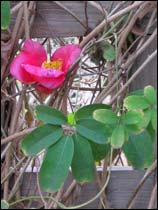 More and more camellias are in bloom in the botanical garden’s glasshouse. The crest comes in early February, but lots of the shrubs are off to an early start. More shrubs in bloom mean more spent flowers on the walks and ground that visitors find hard to resist. Blossoms that aren’t tucked away as souvenirs are often taken outside. There they’re placed in spots where they could belong, but don’t. This morning I saw this rose-colored camellia that someone lodged in the crotch of a still-green chocolate vine. The cold will drain it of color soon, but for now I like the way it intrudes on winter.
More and more camellias are in bloom in the botanical garden’s glasshouse. The crest comes in early February, but lots of the shrubs are off to an early start. More shrubs in bloom mean more spent flowers on the walks and ground that visitors find hard to resist. Blossoms that aren’t tucked away as souvenirs are often taken outside. There they’re placed in spots where they could belong, but don’t. This morning I saw this rose-colored camellia that someone lodged in the crotch of a still-green chocolate vine. The cold will drain it of color soon, but for now I like the way it intrudes on winter.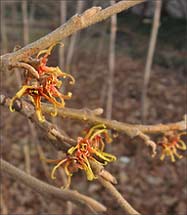 To find flowers that thrive in the cold, I look for witch hazels. This morning along the path through the daylily gardens there’s this variety called ‘Christmas Cheer’ (Hamamelis vernalis) in full flower. Like most witch hazels, ‘Christmas Cheer’ is supposed to have a heady, sweet spicy scent. Whether it does or not, I couldn’t say because the cold deadened my sense of smell.
To find flowers that thrive in the cold, I look for witch hazels. This morning along the path through the daylily gardens there’s this variety called ‘Christmas Cheer’ (Hamamelis vernalis) in full flower. Like most witch hazels, ‘Christmas Cheer’ is supposed to have a heady, sweet spicy scent. Whether it does or not, I couldn’t say because the cold deadened my sense of smell.The keeper of the Ottoman garden decided to winter-over three Oleanders (Nerium oleander ‘Double White’) – two are planted directly in the ground. The other is in a large container pot. Oleanders are normally flowers of sultry summers and frost-free winters. Here the summers fit the bill, but the winters won’t do. However, I’ve been reading a book called Palms Won’t Grow Here and Other Myths: Warm-climate plants for cooler areas by David Francko, a botanist turned horticulturist from Miami University -- the one in Ohio. He says he used to think that oleanders and the Midwest didn’t mix. Then he ordered a ‘Double Yellow’ from Plant Delights Nursery from stock that survived temperatures of -9°F. He says it gets through most winters just fine and even when it’s killed off by the cold, it comes back again in the spring. All the oleanders in this botanical garden’s Zone 6 climate haven’t lost a leaf. Next week though the coldest weather of the season gets here. I’m anxious to see how they’ll look next week after a few nights of temperatures in the single digits. 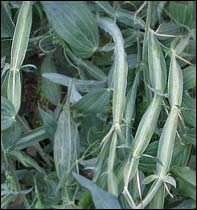 The sweet pea vines trailing over the ground in the Ottoman garden are thriving. Even without flowers, their blue-green vines continue to get longer and to make new tendrils. Their flat stems have segments that bulge and then come together. A pale green vein in the center makes them look like those flat connector wires inside computer cases. The sweet pea vines trailing over the ground in the Ottoman garden are thriving. Even without flowers, their blue-green vines continue to get longer and to make new tendrils. Their flat stems have segments that bulge and then come together. A pale green vein in the center makes them look like those flat connector wires inside computer cases.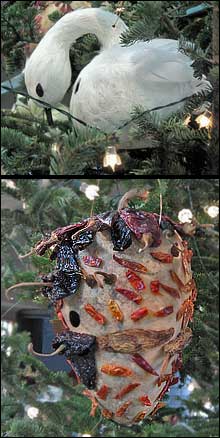 Staffers and volunteers at this botanical garden decorated a live Christmas tree with ornaments they made from gourds. Each of the larger gourds has a round hole cut or drilled into it to make it look like a birdhouse. I suppose the seeds were spooned out of the hole to make the gourd lighter and to keep it from raising a stink. After drying, the shells were painted, etched, decoupaged, or embellished in some way to make them look less like gourds. I asked one of the visitors looking at the ornaments whether she had a favorite. She said she couldn’t pick just one. I found two. One was this crook-necked gourd made to look like a swan by using chicken feathers and a gourd seed painted black. Then there’s this one shaped like a bee skep covered with an assortment of large and small hot peppers. Staffers and volunteers at this botanical garden decorated a live Christmas tree with ornaments they made from gourds. Each of the larger gourds has a round hole cut or drilled into it to make it look like a birdhouse. I suppose the seeds were spooned out of the hole to make the gourd lighter and to keep it from raising a stink. After drying, the shells were painted, etched, decoupaged, or embellished in some way to make them look less like gourds. I asked one of the visitors looking at the ornaments whether she had a favorite. She said she couldn’t pick just one. I found two. One was this crook-necked gourd made to look like a swan by using chicken feathers and a gourd seed painted black. Then there’s this one shaped like a bee skep covered with an assortment of large and small hot peppers.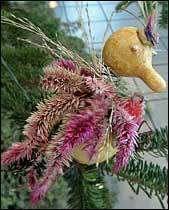 Aside from the gourd birdhouses, there were some smaller gourds on the tree too – each no more than four inches long. With the help of dried celosia, lavender, and weeds the gourds became birds and bird nests. Aside from the gourd birdhouses, there were some smaller gourds on the tree too – each no more than four inches long. With the help of dried celosia, lavender, and weeds the gourds became birds and bird nests.After seeing these gussied-up gourds, I looked around the internet to see if I could find an artist who uses gourds just as they are rather than transforming them into something they’re not. Amy Goldman does. She’s an artist, a grower of hundreds of varieties of heirloom vegetables, a seed saver, a garden writer, and a self-described “vegetable rights activist.” Goldman makes moldings of heirloom gourds that are rendered into bronze sculptures. Her work is on display at the New York Botanical Garden through most of 2008.
|
||||||||||||||||||||||||||||||||||||||||||
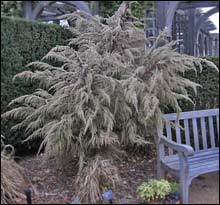 This shrub (Eupatorium capillifolium) is rightly named: ‘Elegant Feather.’ The cold has erased every trace of green. All that’s left are these tiers of overlapping plumes that splay out in every direction to catch the wind. The plumes are soft and yielding. Running my hand along them is like stroking a cat. Image how ‘Elegant Feather’ would look at night if it had a couple of hundred tiny blue bulbs glowing from inside it. Checking the web, I found that Eupatorium capillifolium (commonly called dog fennel) is considered an invasive, noxious weed, especially
This shrub (Eupatorium capillifolium) is rightly named: ‘Elegant Feather.’ The cold has erased every trace of green. All that’s left are these tiers of overlapping plumes that splay out in every direction to catch the wind. The plumes are soft and yielding. Running my hand along them is like stroking a cat. Image how ‘Elegant Feather’ would look at night if it had a couple of hundred tiny blue bulbs glowing from inside it. Checking the web, I found that Eupatorium capillifolium (commonly called dog fennel) is considered an invasive, noxious weed, especially 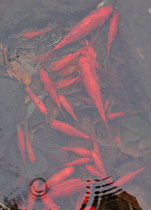 The small pond in the Chinese Garden section of the botanical garden is usually packed with energetic goldfish. This morning the goldfish were there, but nearly all of them were on or near the bottom in the shallowest part of the pond. The fish were huddled together in several large schools. They were very still. I’d never paid much attention to the goldfish when they were moving and active, but seeing them so still made me wonder whether they would survive the winter. According to a piece in
The small pond in the Chinese Garden section of the botanical garden is usually packed with energetic goldfish. This morning the goldfish were there, but nearly all of them were on or near the bottom in the shallowest part of the pond. The fish were huddled together in several large schools. They were very still. I’d never paid much attention to the goldfish when they were moving and active, but seeing them so still made me wonder whether they would survive the winter. According to a piece in 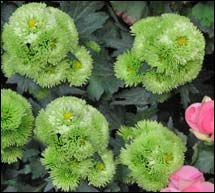 As expected, the botanical garden’s annual holiday show is brimming with poinsettias. I thought the two most interesting plants at the show weren’t poinsettias though. My favorite was a mum with a color and a flowering habit that I’d never seen anywhere before. The variety is named ‘Killeen.’ Its yellow-green flowers bunch together in tight, tiered clusters at the top of a single stock so there’s plenty of deep green foliage to frame the flowers. A mock rose?
As expected, the botanical garden’s annual holiday show is brimming with poinsettias. I thought the two most interesting plants at the show weren’t poinsettias though. My favorite was a mum with a color and a flowering habit that I’d never seen anywhere before. The variety is named ‘Killeen.’ Its yellow-green flowers bunch together in tight, tiered clusters at the top of a single stock so there’s plenty of deep green foliage to frame the flowers. A mock rose?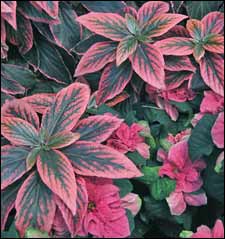 The other surprise were the copperleaf plants (Acalypha) plants tucked in among the poinsettias. The red-oranges and greens of the foliage on this variety named ‘Bourbon Street’ looked right at home with the poinsettia bracts. Getting this far-from-usual plant to this point at this time gives me a inkling of what it must have taken to put a display like this together. Hardly a case of taking a trip to a local poinsettia grower and ordering a dozen of this and another of that.
The other surprise were the copperleaf plants (Acalypha) plants tucked in among the poinsettias. The red-oranges and greens of the foliage on this variety named ‘Bourbon Street’ looked right at home with the poinsettia bracts. Getting this far-from-usual plant to this point at this time gives me a inkling of what it must have taken to put a display like this together. Hardly a case of taking a trip to a local poinsettia grower and ordering a dozen of this and another of that.